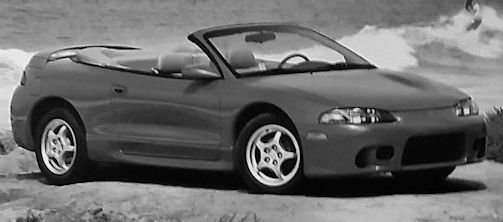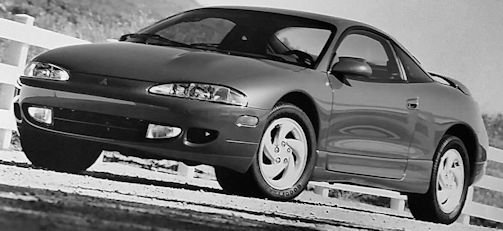Mitsubishi Eclipse 2nd generation
 |
|
|
Model years |
1995 to 1999 |
|
Assembly |
United States: |
|
Body style |
3-door lift back coupé |
|
Layout |
Front-engine, front-wheel-drive |
|
Platform |
Mitsubishi D/Chrysler PJ platform |
|
Engine |
|
|
Transmission |
4-speed automatic |
|
Wheelbase |
2,510 mm (98.8 in) |
|
Length |
1995–96: 4,370 mm (172.2 in) |
|
Width |
1,740 mm (68.7 in) |
|
Height |
1995–96: 1,280 mm (50.2 in) |
|
Curb weight |
RS/GS: 1,235 kg (2,723 lb) |
In autumn 1995, the second generation came on the market, which in the US as a basic model (without turbocharger) another engine of Chrysler (2.0 l DOHC, engine code: D420A) possessed. In the GS-T and GSX remained in the US, the 4G63 engines (which were also installed in the Mitsubishi Lancer Evolution) as the predecessor largely the same. Eclipse comes in hatchback and Spyder convertible form, all with 4-cylinder engines.
History
The RS and GS coupes use a 2.0 Liter, the GS Spyder a 2.4. A turbocharged 2.0 powers the GS-T coupe, Spyder, and GSX coupe. The GSX has all-wheel drive;
other models are front drive. All offer manual transmission or optional automatic. Convertibles have a power top and glass rear window. For the EU, again only the basic model with 4G63 engine (up to 1996: emission classification Euro 1 with 107 kW and Euro 2 with 104 kW) was available for sale, externally only with the standard double pipe exhaust on the older Euro 1 Version recognizable.

In contrast to the previous model, there was also a "Spyder" convertible version. This full-top convertible with soft top was offered on the 2.4-liter 4G64 105 kW (143 hp) naturally aspirated engine as well as in the 2.0-l GS-T turbocharged version with the 157 kW (214 hp) 4G63T engine. However, Mitsubishi did not sell the Spyder in Europe.
1996 Updates
Eclipse GS Powered by a 2.0-liter, 140-horsepower, double overhead camshaft (DOHC), 16-valve engine, with 4-speed automatic transmission receives a new on-board diagnostic system (OBD II) 5-speed Eclipse GS has met OBD Il requirements since the 1995 model year and the Mitsubishi HomeLink System. Mitsubishi HomeLink enables the driver to control as many as three radio frequency devices (such as garage door opener, home security system, and an available home lighting system), providing safety and convenience. Three bold new exterior colours improve the appearance of '96 Eclipses: Oslo Green Pearl; Monarch Green Pearl and Celtic Blue Pearl. Standard features on Eclipse GS include: split fold-down rear seat; height-adjustable steering column; driver- and front passenger-side air bags; integrated fog lamps; full instrumentation and waning lights; 6-speaker AM/FM stereo cassette player; power remote-control sideview mirrors; and 16-inch wheels and tires.
New for 1996 features on Eclipse GSX include: the Mitsubishi HomeLink System, which enables the driver to control as many as three radio frequency devices (such as garage door opener, home security system, and an available home lighting system); a new Mitsubishi 'infinity' premium audio stereo system with optional 10-disc compact disc auto-changer, and a new panic button feature for the Remote Keyless Entry and Security System option. Standard features on Eclipse GSX include: diver- and front passenger-side air bags; full leather seating areas on front seats, with power driver's seat; power windows and door locks; integrated fog lamps; and 16-inch alloy wheels.
In the summer of 1998, the Eclipse received a facelift (modified bumpers, side skirts, headlights / fog lights, colour of the interior and fabric of the seats). In addition, the ABS supplied by Bosch was overhauled, which very often failed in the years of construction 1995 to 1997 (splashing water damage in the ABS hydraulic block). With the introduction of a new ABS, the passenger footwell became deeper because the control unit was integrated into the ABS hydraulic block for this purpose. This year, anti-lock brakes are newly standard on the GSX; they remain optional for other Eclipses except the RS. The GSX also gets a limited-slip rear differential as standard, while the GS-T coupe adds a power moonroof and keyless-entry security system. White-face gauges are newly standard on GSX and both GS-Ts, and are included in a new Sports Value Package option that dresses up the GS coupe with a GSX-style rear spoiler, air conditioning, the security system, leather front-seat surfaces, in-dash CD player, and power windows, locks, and moonroof. A CD player is newly standard on the RS.

The base 2.0-liter engine is the same Chrysler-designed 4-cylinder used in the Dodge and Plymouth. Acceleration with automatic is ok for a sports coupe. Progress is livelier with the slick-shifting 5-speed. Eclipse GSX is the ultimate Eclipse model with its 210-horsepower (hp) with optional automatic 4-speed electronically controlled transmission, Eclipse GSX's turbocharged, intercooled, double overhead camshaft (DOHC), 16-valve engine revs freely as Mitsubishi Motors' advanced full-time All-Wheel Drive (AWD) system grips the road firmly. Four-wheel disc brakes with optional anti-lock braking system (ABS) bring the vehicle to a halt decisively.
- 2.0 l, 1997 cc, R4, 107 kW (146 hp) until 1996
Acceleration 0-100 km / h in 9.4 s, top speed 220 km / h.
- 2.0 l, 1997 cc, R4, 104 kW (141 hp) from 1996
Acceleration 0-100 km / h in 9.5 s, top speed 217 km / h.
Mitsubishi Eclipse GS Spyder
- 2.4 l, 2389 cc, R4, 105 kW (143 hp)
Mitsubishi Eclipse GS-T Spyder
- 2.0 l, 1997 cc, R4 Turbo, 157 kW (214 hp)
Mitsubishi Eclipse GSX and GS-T
- 2.0 l, 1997 cc, R4 Turbo, 157 kW (214 hp)
GST accelerates from 0-100 km / h in 6.8 s.
GSX accelerates from 0-100 km / h in 6.5 s.
The maximum speed was 220 km / h for the GSX and GS-T.
STANDARD EQUIPMENT:
- RS: 2.0-liter DOHC 4-cylinder engine, 5-speed manual or 4-speed automatic transmission, driver- and passenger-side air bags, variable-assist power steering, tilt steering column, cloth upholstery, reclining front bucket seats, 5-way adjustable driver seat w/memory recline feature, front storage console w/cupholders, folding rear seat, tachometer, coolant-temperature gauge, trip odometer, AM/FM/cassette w/6-speakers, digital clock, map lights, remote fuel-door release, rear defogger, remote hatch release, cargo light, tinted glass, dual outside mirrors, 195/70HR14 tires, wheel covers.
- GS adds: 4-wheei disc brakes, 6-way adjustable driver seat w/memory feature, split folding rear seat, power mirrors, universal garage-door opener, rear wiper/washer, cargo cover and net, bodyside cladding, low rear spoiler, fog lights, 205/55HR16 tires.
- Spyder GS adds to RS: 2.4-liter 4-cylinder engine, air conditioning,6-way adjustable driver seat w/memory recliner feature, power mirrors, power windows, power door locks, AM/FM/CD player, power insulated soft top with glass rear window, vinyl tonneau cover, alloy wheels.
- GS-T adds to GS: 2.0-liter DOHC 4-cylinder turbocharged and intercooled engine, air conditioning, cruise control, oil-pressure gauge, turbo-boost gauge, Infinity 8-speaker AM/FM/cassette/CD player w/amplifier and CD changer controls, power windows, power door locks, dual bright exhaust outlets, high rear spoiler, sport suspension, 205/55HR16 tires, chrome alloy wheels.
- Spyder GS-T adds: leather-upholstery, leather-wrapped steering wheel and shift knob, remote keyless entry, theft-deterrent system, power insulated soft top with glass rear window, vinyl tonneau cover,205/55VR16 tires.
- GSX adds to GS-T: all-wheel drive, leather upholstery, leather-wrapped steering wheel and shift knob, power driver seat, power moonroof, remote keyless entry, theft-deterrent system, 215/50VR17 tires, plain alloy wheels.
Manuals
-
Mitsubishi Previous 19 / 55 Next
